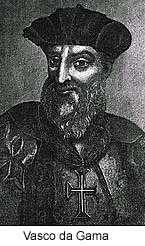

 |  |
 European interest in India has persisted since classical times and for very cogent reasons. India had much to give Europe in the practical form of spices, textiles, and other oriental products. When direct contact was lost after the fall of Rome and the rise of Muslim Arabs the trade was carried out through middlemen. In the late Middle Ages it increased with the increasing prosperity of Europe. It should be remembered that spice trade was not just a luxury trade at that time.
European interest in India has persisted since classical times and for very cogent reasons. India had much to give Europe in the practical form of spices, textiles, and other oriental products. When direct contact was lost after the fall of Rome and the rise of Muslim Arabs the trade was carried out through middlemen. In the late Middle Ages it increased with the increasing prosperity of Europe. It should be remembered that spice trade was not just a luxury trade at that time. Spices were used to preserve meat through the winter. The trade suffered two threats in the later Middle ages. There was the threat of Mongol and Turkish invasion which interfered with the land routes and threatened to engulf the sea route through Egypt, and there was the threat of monopoly shared between Venetians & Egyptians. Crusading zeal against Muslims and commercial zeal against spice monopolists were the motives which sent Columbus to America and Vasco da Gama to Calicut in 1498. Vasco da Gama told the first Indians he met on the Malabar coast that he came to seek 'Christians and Spices'. The Christians he was seeking were the legendary people to be rescued from Muslim encirclement, they were in fact Abyssinians whom da Gama never met. The Portuguese soon found that Malabar was as important a centre for re-export of spices from the East Indies as for the sale of its own limited range of pepper and cardamom. They also found that the trade with Egypt and so with Europe was in the hands of Arab merchants. So a double strategy was developed. A series of strong points was established so as to dominate both the East Indies and the Arabian sea. The object of the former measure was to control the spice trade at its principal sources from Java to the Mulucca Islands (home of the clove) and of the latter to cut off the Arabian-managcd spice trade from south India to Egypt and the Persian Gulf. In this way the European spice trade would be diverted to Portuguese ships and toll could be taken (by a system of licences) of all the remaining maritime trade of the Indian ocean. The Portuguese were largely successful in their venture because of the superior power of their ships, whose guns could blow most 'country ships' of the time out of the water, of the daring and endurance of their captains and men, and of the genius of Aflonso de Albuquerque.* It was he who in 1510 captured Goa on the west coast of India from the Sultan of Bijapur and made it the capital of the Portuguese eastern empire. continued.... next page >> |
Copyright ©2000 indiansaga.info. All rights reserved.
By using this service, you accept that you won't copy or use the data given in this website for any commercial purpose.
The material on indiansaga.info is for informational & educational purpose only.
This site is best viewed at 800 X 600 picture resolution.